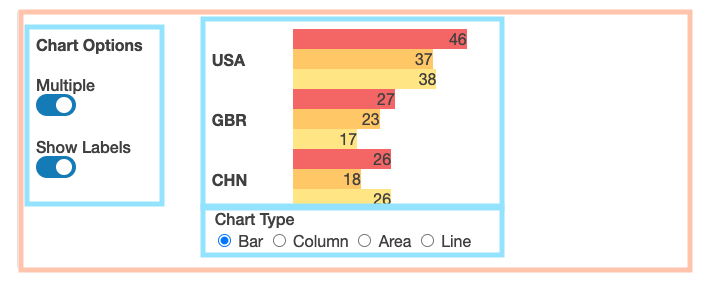Component Communication in Enhance

by Simon MacDonald
@macdonst@mastodon.online
on

Enhance makes it easy to build applications composed of web components. Each component encapsulates its own UI and functionality. However, under some circumstances you may need to communicate between components to share data or react to changes elsewhere on the page. In this post, we are going to learn a few ways of achieving communication between components.
In our first example we will build a chart component that is composed of three child components (blue border): chart-options, chart-type and reactive-chart and their parent component (orange border) chart-container.

Child to Parent communication
For this type of communication, we leverage the web platform by using Events for communication from child to parent.
In our example app, when the user clicks on the “Show Labels” switch we want to toggle whether or not the labels are displayed on our chart. This means we will need to build a web component that listens to the change event from the switch, marshals up the important data and then fires a CustomEvent that the parent component will listen to.
Here’s the full code listing for you to look over then we’ll point out some of the salient features.
import CustomElement from '@enhance/custom-element'
export default class ChartOptions extends CustomElement {
constructor() {
super()
this.optionChanged = this.optionChanged.bind(this)
}
connectedCallback() {
this.addEventListener('change', this.optionChanged)
}
disconnectedCallback() {
this.removeEventListener('change', this.optionChanged)
}
optionChanged(evt) {
this.dispatchEvent(
new CustomEvent("chartoption", {
bubbles: true,
detail: {
attribute: evt.target.name,
value: evt.target.checked
},
}),
)
}
render({ html }) {
return html`
<slot></slot>
`
}
}
customElements.define("chart-options", ChartOptions);In the web component’s constructor method on line 6 you might notice this code:
this.optionChanged = this.optionChanged.bind(this)We do this so that when the optionsChanged event listener is invoked that this is bound to our web component instead of the default binding which would be undefined.
Next we’ll register/unregister our event listener in our connectedCallback and disconnectedCallback methods.
connectedCallback() {
this.addEventListener('change', this.optionChanged)
}
disconnectedCallback() {
this.removeEventListener('change', this.optionChanged)
}This is my preference for handling event listeners. There is some discussion about whether or not this is a best practice. See Nolan Lawson, Hawk Ticehurst, and Chris Ferdinandi.
Then in our optionsChanged event handler we create a CustomEvent called chartoption which will be dispatched up the DOM to our parent component.
optionChanged(evt) {
this.dispatchEvent(
new CustomEvent("chartoption", {
bubbles: true,
detail: {
attribute: evt.target.name,
value: evt.target.checked
},
}),
)
}By using a CustomEvent we can differentiate our change event from other change events elsewhere on the page and customize our payload.
Note: You may be wondering why we fire a CustomEvent instead of letting the change event bubble up to our parent component. There are two very good reasons for this. The first is that we want to encapsulate the business logic into our chart-options component. Since the parent component is listening for a chartoption event changing the underlying implementation of the chart-options component can be done without disturbing the parent component. Secondly, we have another component called chart-type which would also be firing a change event and we want to be able to differentiate between the two components easily.
Finally, our render method is quite short:
render({ html }) {
return html`
<slot></slot>
`
}As we are using the HTML web components pattern. Our web component is just a wrapper around our checkbox input element. For example:
<chart-options>
<e-input-group field-class="flex justify-content-between align-items-center">
<fieldset>
<label>Multiple</label>
<e-switch>
<input is="switch" type="checkbox" name="multiple" checked>
</e-switch>
</fieldset>
</e-input-group>
</chart-options>With all this in place we are now able to communicate state changes from child components to the parent using the native web platform but how does the parent component listen for this chartoption event?
Parent to Child communication
In the previous section our child component was firing a chartoption event. Our parent component needs to listen for this event and communicate down to the child components by setting attributes on the child component.
Once again here is the full code listing. We’ll call out the important bits next.
import CustomElement from '@enhance/custom-element'
export default class ChartContainer extends CustomElement {
constructor() {
super()
this.updateOption = this.updateOption.bind(this)
this.updateType = this.updateType.bind(this)
this.chart = document.querySelector('reactive-chart')
}
connectedCallback() {
this.addEventListener('chartoption', this.updateOption)
this.addEventListener('charttype', this.updateType)
}
disconnectedCallback() {
this.removeEventListener('chartoption', this.updateOption)
this.removeEventListener('charttype', this.updateType)
}
updateOption(evt) {
const { attribute, value } = evt.detail
if (value) {
this.chart.setAttribute(attribute, '')
} else {
this.chart.removeAttribute(attribute)
}
}
updateType(evt) {
const { type } = evt.detail
this.chart.setAttribute('type', type)
}
render({ html }) {
return html`
<e-box ord="primary">
<e-row>
<e-col span="3">
<h4 class="mar-t-xs">Chart Options</h4>
<chart-options>
<e-input-group field-class="flex justify-content-between align-items-center" >
<fieldset>
<label>Multiple</label>
<e-switch>
<input is="switch" type="checkbox" name="multiple" checked>
</e-switch>
</fieldset>
</e-input-group>
<e-input-group field-class="flex justify-content-between align-items-center" >
<fieldset>
<label>Show Labels</label>
<e-switch>
<input is="switch" type="checkbox" checked name="show-labels" >
</e-switch>
</fieldset>
</e-input-group>
</chart-options>
</e-col>
<e-col>
<div>
<reactive-chart
data-key="medals"
type="bar"
heading="2016 Summer Olympics Medal Table"
value-key="Country"
value-names="Gold,Silver,Bronze"
multiple
show-labels>
</reactive-chart>
<chart-type>
<e-input-group enhanced="✨">
<legend>Chart Type</legend>
<fieldset>
<input id="bar" type="radio" name="type" value="bar" checked>
<label for="bar">Bar</label>
<input id="column" type="radio" name="type" value="column">
<label for="column">Column</label>
<input id="area" type="radio" name="type" value="area">
<label for="area">Area</label>
<input id="line" type="radio" name="type" value="line">
<label for="line">Line</label>
</fieldset>
</e-input-group>
</chart-type>
</div>
</e-col>
</e-row>
</e-box>
`
}
}
customElements.define("chart-container", ChartContainer);In our connectedCallback method we are listening for two CustomEvents. The first one for chartoption is the only one we’ll be going in depth into for this example.
connectedCallback() {
this.addEventListener('chartoption', this.updateOption)
this.addEventListener('charttype', this.updateType)
}When our chart-container component receives a chartoption event it calls the updateOption method:
updateOption(evt) {
const { attribute, value } = evt.detail
if (value) {
this.chart.setAttribute(attribute, '')
} else {
this.chart.removeAttribute(attribute)
}
}From the event’s details we can pull off the name of the attribute we need to set and whether the switch is on or off. If our value is true we set an attribute on the reactive-chart component. If our value is false, we remove the attribute.
Note: for more details on dealing with binary attributes see MDN.
With this attribute being added or removed from the reactive-chart component, it will be notified via its attributeChangedCallback. Then our chart can re-render itself based on the updated attributes.
Check out the demo and source code for this example.
Shared State or Store
For larger applications, managing state between multiple components can become complex. In such cases, using a shared state management solution can be beneficial and that’s why @enhance/store exists. Store based communication is not limited to a parent-child relation. You can share information between any components.
In our second example we’ll simplify our chart component that is still composed of three child components (blue border): chart-options, chart-type and reactive-chart. We will replace CustomEvents with a shared state so that sibling elements can communicate with each other instead of requiring a parent element to receive events and pass down attribute changes.

@enhance/store is a singleton reactive data store. The store provides an interface that allows components to subscribe to updates to the store or specific properties on the store.
For our example we will create a new file called app/browser/api.mjs. That is where we will initialize our store.
import Store from '@enhance/store'
const store = Store()
export default function API() {
initialize()
return {
store,
subscribe: store.subscribe,
unsubscribe: store.unsubscribe
}
}This API interface will give components access to our store and a convenient way to subscribe/unsubscribe the changes to data in the store.
For our “position” selection box we will use the chart-options component from the previous example. Switching it from firing a CustomEvent to updating the store. The optionChanged method becomes:
optionChanged(evt) {
this.api.store.position = evt.target.value
}Since we are no longer sending CustomEvents the chart-container component becomes purely presentational. You can remove all of the business logic and just have a render method. For example:
import CustomElement from '@enhance/custom-element'
export default class ChartContainer extends CustomElement {
render({ html }) {
return html`
<e-row>
<e-col colspan="12">
<e-box ord="primary">
<e-row>
<e-col>
<chart-type>
<e-input-group>
<legend>Sort By</legend>
<fieldset>
<input id="goals" type="radio" name="type" value="goals">
<label for="goals">Goals</label>
<input id="assists" type="radio" name="type" value="assists">
<label for="assists">Assists</label>
<input id="points" type="radio" name="type" value="points" checked>
<label for="points">Points</label>
</fieldset>
</e-input-group>
</chart-type>
</e-col>
<e-col>
<chart-options>
<e-input-group field-class="flex justify-content-between align-items-center" >
<fieldset>
<select>
<option value="all">Position</option>
<option value="C">Centre</option>
<option value="L">Left Wing</option>
<option value="R">Right Wing</option>
<option value="D">Defence</option>
</select>
</fieldset>
</e-input-group>
</chart-options>
</e-col>
</e-row>
<reactive-chart
data-key="scorers"
type="points"
heading="2023 NHL Scoring Leaders"
value-key="Points"
value-names="Goals,Assists,Points"
position="all"
multiple
show-labels>
</reactive-chart>
</e-box>
</e-col>
</e-row>
`
}
}
customElements.define("chart-container", ChartContainer);Now in our reactive-chart we’ll subscribe to changes in the store.
connectedCallback() {
this.api.subscribe(this.update,['chartData', 'position', 'type'])
}
disconnectedCallback() {
this.api.unsubscribe(this.update)
}If the chart-options or chart-type component updates the state the update method of reactive-chart will be invoked.
update(payload) {
if (payload.position) {
this.setAttribute('position', payload.position)
}
if (payload.type) {
this.setAttribute('type', payload.type)
}
if (payload.chartData) {
// re-render chart with updated data
}
}Then the component takes advantage of the attributeChangedCallback to re-render itself based on the position or type filter you set.
Check out the demo and source code for this example.
Final Thoughts
By leveraging what the web platform already provides we can communicate between parent and child components by passing attributes down to the child and events up to the parent. This is enough for most web applications and we caution you not to rush into more complicated solutions. When interactions get more complex, then consider adopting a shared state solution like @enhance/store.